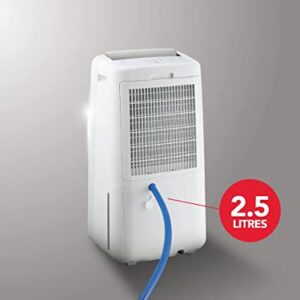Dehumidifier emerges as powerful ally. Designed to extract excess humidity from the air, this essential appliance plays a vital role in creating a comfortable and healthy indoor environment. In this article, we explore the concept of dehumidifiers, their working principles, and the benefits they offer. Discover how a dehumidifier can transform your living space into a haven of freshness and well-being.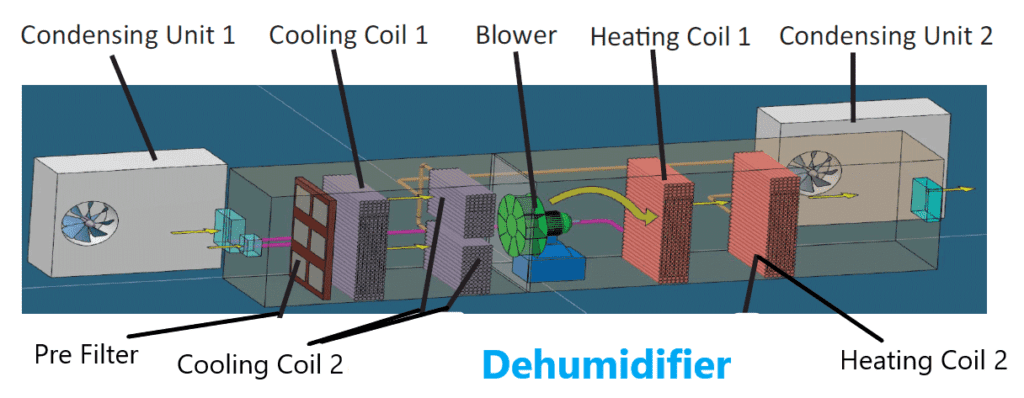
What is dehumidifier
The device stands tall as the unsung hero of comfort and well-being: the dehumidifier. With its uncanny ability to extract excess moisture from the air, this ingenious contraption has revolutionized the battle against oppressive humidity levels. In this article, we delve into the intricacies of dehumidifiers, exploring their mechanisms, benefits, and their unwavering commitment to creating an atmosphere of optimum dryness.
The Perplexing Concept of Dehumidification: At its core, a dehumidifier is a device designed to reduce and control the moisture content in the air. Excessive humidity can lead to a host of problems, such as mold growth, musty odors, and discomfort. Dehumidifiers tackle these issues head-on by employing various methods to extract moisture and maintain a balanced humidity level. By understanding the science behind dehumidification, we can appreciate the significant role these devices play in improving indoor air quality.
Mechanisms of Moisture Extraction: Dehumidifiers employ a range of techniques to effectively extract moisture from the air. One common method involves condensation, where humid air is cooled, causing water vapor to condense into liquid form. This condensed moisture is then collected and drained away, leaving behind drier air. Another approach involves absorption, where moisture is absorbed by a desiccant material, such as silica gel, which is then heated to release the collected water vapor. Both methods aim to reduce the humidity level, creating a more comfortable and healthier environment.
The Benefits of Optimum Humidity: The impact of dehumidifiers extends far beyond moisture control. By maintaining an optimal humidity level, these devices offer a range of benefits. In homes, dehumidifiers help prevent the growth of mold and mildew, which can damage surfaces and lead to respiratory issues. They also alleviate the discomfort associated with high humidity, such as clammy skin and difficulty in breathing. In commercial settings, dehumidifiers play a vital role in preserving goods, protecting equipment, and ensuring the well-being of employees and customers. Furthermore, dehumidifiers can enhance energy efficiency by reducing the load on air conditioning systems, as drier air feels cooler, allowing for higher thermostat settings.
Choosing the Right Dehumidifier: Selecting the appropriate dehumidifier for your needs is essential to reap its benefits fully. Factors such as the size of the area, desired humidity level, and specific requirements should be considered. Dehumidifiers come in various capacities, with larger units suitable for larger spaces. Energy efficiency ratings, noise levels, and additional features, such as built-in humidistats or air purifiers, are also considerations when making a choice. Consulting with experts or reviewing product specifications can help ensure the right fit for your unique situation.
Maintenance and Care: Like any appliance, dehumidifiers require regular maintenance to operate effectively. It is crucial to clean or replace filters as recommended to maintain optimal airflow and filtration efficiency. Emptying the collected moisture regularly prevents overflow and ensures continued performance. Additionally, periodic checks and cleaning of the unit’s coils and drainage system help prevent clogs and maximize efficiency. Adhering to manufacturer instructions and routine maintenance schedules will help prolong the lifespan and functionality of your dehumidifier.
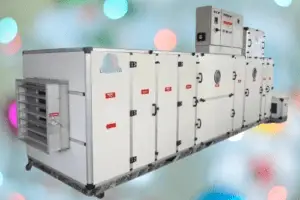
Types of industrial dehumidifier
Industrial environments often face unique challenges when it comes to controlling moisture levels. Excessive humidity can lead to corrosion, mold growth, and compromised product quality. Industrial dehumidifiers come to the rescue, offering robust solutions to combat these issues. In this article, we delve into the world of industrial dehumidifiers, exploring their various types and applications, empowering businesses to make informed decisions in their quest for optimal moisture control.
Desiccant Dehumidifiers:
Desiccant dehumidifiers are widely used in industrial settings due to their versatility and effectiveness. They operate by passing moist air over a desiccant material, such as silica gel or activated alumina, which absorbs the moisture. The desiccant material is then heated to release the collected moisture, and the process repeats. These dehumidifiers excel in low humidity environments, as they can achieve very low dew points. They are commonly employed in industries like pharmaceuticals, food processing, and electronics manufacturing, where precise humidity control is critical.
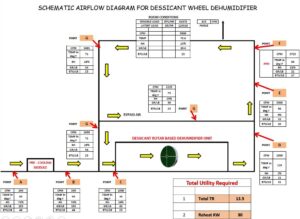
Refrigerant-based Dehumidifiers:
Refrigerant-based dehumidifiers, also known as condensation dehumidifiers, are another popular choice in industrial applications. They function by cooling the air to condense and remove moisture. The humid air passes over a cold coil, causing water vapor to condense into liquid form, which is then drained away. Refrigerant-based dehumidifiers are efficient and well-suited for environments with higher temperatures and humidity levels. They find applications in warehouses, production facilities, and storage areas, where maintaining a controlled humidity level is essential for preserving goods and ensuring optimal working conditions.
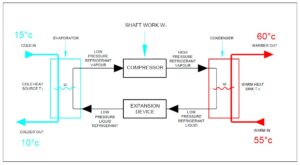
Low Grain Refrigerant (LGR) Dehumidifiers:
LGR dehumidifiers are an advanced version of refrigerant-based dehumidifiers. They incorporate additional features to tackle extreme humidity challenges effectively. LGR dehumidifiers utilize a pre-cooling mechanism that further lowers the temperature of the air before it reaches the cold coil. This enables them to extract moisture even in highly saturated environments. LGR dehumidifiers are commonly used in water damage restoration, construction sites, and industrial drying applications, where rapid and efficient moisture removal is required.
Ventilation Dehumidifiers:
Ventilation dehumidifiers work by continuously exchanging indoor air with fresh, drier air from outside. These units incorporate fans and air filters to bring in fresh air while expelling moist indoor air. Ventilation dehumidifiers are useful in scenarios where controlling humidity levels alone is not sufficient, such as areas with high pollutant levels or in situations where maintaining proper ventilation is crucial. They are commonly used in industrial kitchens, laboratories, and indoor farming facilities, where maintaining air quality and controlling humidity go hand in hand.
High-Capacity Dehumidifiers:
For large-scale industrial operations, high-capacity dehumidifiers provide the necessary firepower to tackle moisture-related challenges. These units are designed to handle vast volumes of air and extract significant amounts of moisture. High-capacity dehumidifiers are utilized in warehouses, manufacturing plants, sports facilities, and other expansive spaces where effective moisture control is imperative. They offer powerful performance, rapid drying capabilities, and are often equipped with advanced features for remote monitoring and control.
Applications of the dehumidifier
| Application | Description |
|---|---|
| Home | Reduces humidity levels, prevents mold growth, and improves air quality in bedrooms, living rooms, basements, and bathrooms. |
| Office and Commercial Spaces | Maintains optimal humidity for employee comfort, protects sensitive equipment, and prevents damage to documents and materials. |
| Warehouses and Storage | Controls moisture to prevent condensation, mold, and mildew on stored goods, ensuring their quality and longevity. |
| Laboratories | Provides precise humidity control for sensitive experiments, equipment, and samples, maintaining accuracy and reliability. |
| Museums and Archives | Preserves delicate artifacts, paintings, manuscripts, and historical documents by controlling humidity levels to prevent deterioration. |
| Indoor Pool Areas | Manages moisture to prevent condensation on surfaces, maintains a comfortable environment, and protects pool equipment. |
| Gymnasiums and Sports Facilities | Controls humidity to prevent unpleasant odors, mold growth, and damage to equipment and flooring. |
| Greenhouses | Regulates humidity to create an ideal environment for plant growth, preventing excessive moisture-related issues and plant diseases. |
| Water Damage Restoration | Aids in drying out flooded or water-damaged areas to prevent mold growth, structural damage, and promote quick recovery. |
| Medical Facilities | Maintains proper humidity levels in operating rooms, laboratories, and patient areas for infection control and patient comfort. |
Uses of dehumidifier
| Application | Description |
|---|---|
| Manufacturing Areas | Controls humidity levels in cleanrooms, production areas, and packaging rooms to maintain product quality and stability. |
| Storage and Warehousing | Prevents moisture-related degradation of raw materials, active pharmaceutical ingredients (APIs), and finished products in storage facilities. |
| Research and Development | Provides precise humidity control in laboratories for testing and development of pharmaceutical formulations and stability studies. |
| Stability Chambers | Maintains optimal humidity conditions in stability chambers to ensure accurate and reliable shelf-life testing of pharmaceutical products. |
| Packaging and Labeling | Controls moisture to prevent the deterioration of packaging materials, labels, and adhesive quality, ensuring product integrity. |
| Cold Chain Management | Assists in the transportation and storage of temperature-sensitive pharmaceuticals by reducing moisture and preventing moisture-related damage. |
| Equipment Preservation | Protects sensitive laboratory equipment, such as analytical instruments and electronic devices, from moisture-related malfunctions and corrosion. |
| Controlled-Environment Rooms | Regulates humidity in controlled-environment rooms, such as quarantine areas or specific production zones, to meet regulatory requirements. |
| Cleanroom Environments | Ensures strict control of humidity levels in cleanrooms to maintain the integrity and sterility of pharmaceutical products during manufacturing and packaging. |
| Moisture-Sensitive Processes | Assists in moisture-sensitive processes, such as granulation or drying, where precise humidity control is crucial for optimal product quality. |
Dehumidifier for room
In the pursuit of creating a comfortable living space, a dehumidifier proves to be an invaluable asset. Designed specifically for room applications, these compact devices work tirelessly to control moisture levels and enhance indoor air quality. In this article, we explore the benefits and features of dehumidifiers for rooms, shedding light on their significance in creating a pleasant and healthy environment.
Efficient Moisture Control:
Dehumidifirs for rooms excel in extracting excess moisture from the air, helping to combat issues such as dampness, musty odors, and mold growth. These devices operate by drawing in humid air and passing it over cooling coils. As the air cools, the moisture condenses, forming droplets that are collected and stored in a reservoir. The purified and drier air is then released back into the room, creating a more pleasant and comfortable atmosphere.
Compact and User-Friendly Design:
Room dehumidifirs are specifically designed to fit seamlessly into various indoor spaces. They come in a range of sizes, ensuring compatibility with rooms of different dimensions. Their compact and portable nature allows for easy placement and relocation as needed. Many models feature user-friendly controls and displays, making it simple to adjust settings, monitor humidity levels, and set timers. Some even offer additional features such as built-in air filters to improve air quality.
Quiet Operation:
Noise can be a significant concern when it comes to appliances used in living spaces. Fortunately, room dehumidifirs are engineered to operate quietly, ensuring minimal disruption to daily activities and promoting a peaceful environment. Advanced technologies, such as sound-dampening materials and quiet-running compressors, contribute to the overall noise reduction, allowing you to enjoy the benefits of a dehumidifir without unwanted disturbances.
Energy Efficiency:
Energy efficiency is a key consideration when selecting a room dehumidifer. Many models are designed to optimize power consumption, helping to reduce electricity bills while maintaining effective moisture control. Look for dehumidifers with Energy Star ratings or energy-saving features such as programmable timers and auto-shutoff functions. These features enable the device to operate only when necessary, conserving energy without compromising performance.
Health and Comfort Benefits:
By reducing excessive humidity, room dehumidifirs offer a range of health and comfort benefits. They create an environment less conducive to the growth of mold, mildew, and dust mites, which can trigger allergies and respiratory issues. Lower humidity levels also help alleviate discomfort caused by clammy skin, stuffy air, and difficulty in breathing. With a dehumidifir in your room, you can enjoy a refreshing and pleasant atmosphere that promotes well-being.
best dehumidifier in India
hen it comes to determining the best dehumidifir in India, several factors need to be considered, such as performance, features, energy efficiency, and customer reviews. While individual preferences may vary, here are a few popular dehumidifirs available in the Indian market that have received positive feedback:
- Philips 2-in-1 Dehumidifier: Known for its efficiency and versatility, this dehumidifer offers both dehumidification and air purification capabilities. It comes with features like digital humidity control, automatic humidity settings, and a multi-stage air filtration system.
- Voltas 50 L Dehumidifier: With a large moisture removal capacity, this dehumidifir is suitable for bigger spaces. It includes features such as an LED display, adjustable humidity settings, automatic defrosting, and a user-friendly control panel.
- Honeywell Portable Dehumidifir: This portable dehumidifir is known for its compact size and portability. It offers features like digital controls, adjustable humidity levels, a transparent water tank, and a built-in handle for easy maneuverability.
- Sharp DW-E16FA-W Dehumidifir: This dehumidifir combines functionality with energy efficiency. It includes features such as an auto-restart function, intelligent humidity control, a washable filter, and a large water tank capacity.
- Blue Star 1.5 Ton Portable Dehumidifir: Designed for larger spaces, this dehumidifir has a high moisture removal capacity. It offers features like an LED display, adjustable humidity levels, a built-in pump for continuous drainage, and a timer function.
It is important to consider the specific requirements of your space, such as room size and humidity levels, before selecting the best dehumidifir. Additionally, comparing prices, warranty periods, and after-sales service is recommended to make an informed decision. Reading customer reviews and seeking recommendations from trusted sources can also help in choosing the best dehumidifir in India.
Frequently Asked Questions
What is the recommended humidity range for pharmaceutical industrial dehumidifiers?
Answer: The recommended humidity range for pharmaceutical industrial dehumidifirs is typically between 30% to 50% relative humidity (RH) to maintain optimal conditions for pharmaceutical production and storage.
How do pharmaceutical industrial dehumidifiers control humidity levels?
Answer: Pharmaceutical industrial dehumidifirs control humidity levels by drawing in moist air, passing it over cooling coils to condense the moisture, and then reheating the air before releasing it back into the space. This process effectively removes excess moisture from the air, maintaining desired humidity levels.
What are the key components of a pharmaceutical industrial dehumidifir?
Answer: The key components of a pharmaceutical industrial dehumidifir typically include a compressor, evaporator coils, condenser coils, a fan, a humidistat or humidity controller, and a drainage system for collected moisture.
What is the maximum moisture removal capacity of a typical pharmaceutical industrial dehumidifier?
Answer: The maximum moisture removal capacity of a pharmaceutical industrial dehumidifir can vary depending on the model and size, but it is typically measured in liters or gallons per day. Capacities can range from a few liters to several hundred liters per day.
How does a pharmaceutical industrial dehumidifier prevent condensation on surfaces?
Answer: Pharmaceutical industrial dehumidifirs prevent condensation on surfaces by maintaining the air at a lower dew point temperature. By removing excess moisture from the air, the dehumidifer ensures that the air does not reach its dew point, preventing condensation on surfaces.
What are the different control options available for pharmaceutical industrial dehumidifiers?
Answer: Pharmaceutical industrial dehumidifers may offer various control options, including manual controls, digital control panels with adjustable humidity settings, programmable timers, remote control capabilities, and integration with building management systems (BMS).
Can pharmaceutical industrial dehumidifiers be integrated with building management systems (BMS)?
Answer: Yes, many pharmaceutical industrial dehumidifers can be integrated with building management systems (BMS) for centralized control and monitoring, allowing for seamless integration with other HVAC systems and enabling data logging and analysis.
What safety features should be considered when selecting a pharmaceutical industrial dehumidifier?
Answer: When selecting a pharmaceutical industrial dehumidifer, important safety features to consider include high-temperature protection, low-temperature protection, frost prevention mechanisms, fault alarms, and emergency shut-off options.
What are the energy efficiency ratings or certifications to look for in a pharmaceutical industrial dehumidifier?
Answer: Energy efficiency ratings or certifications to look for in a pharmaceutical industrial dehumidifer include ENERGY STAR® certification, AHRI (Air-Conditioning, Heating, and Refrigeration Institute) certification, and compliance with industry standards such as ASHRAE (American Society of Heating, Refrigerating and Air-Conditioning Engineers) guidelines.
How does the airflow rate of a pharmaceutical industrial dehumidifier impact its performance?
Answer: The airflow rate of a pharmaceutical industrial dehumidifer affects its performance by determining the speed at which moist air is drawn in, dehumidified, and released back into the space. Higher airflow rates generally result in faster moisture removal and improved dehumidification performance.
Are pharmaceutical industrial dehumidifiers equipped with air filtration systems?
Answer: Yes, many pharmaceutical industrial dehumidifers are equipped with air filtration systems to remove airborne particles and improve.
What Does a Dehumidifier Do?
Answer: A dehumidifer is an appliance designed to reduce the humidity level in the air. It works by drawing in moist air, extracting the excess moisture, and releasing drier air back into the room. The primary function of a dehumidifer is to create a more comfortable and healthier indoor environment by controlling humidity levels.
Can a Dehumidifier Cool a Room?
Answer: While a dehumidifer may have a cooling effect, its primary purpose is not to cool the room like an air conditioner. The cooling effect of a dehumidifer is a byproduct of the dehumidification process. As the air passes over the cold evaporator coils in the dehumidifer, the temperature may drop slightly. However, the cooling effect is not as significant as that of an air conditioner, which is specifically designed to cool the air.
Can a Dehumidifier Dry Clothes?
Answer: Dehumidifers are not specifically designed to dry clothes like a dryer. While they do extract moisture from the air, the dehumidification process may not be efficient or powerful enough to effectively dry clothes. It is recommended to use a dedicated clothes dryer or air-drying methods for drying clothes, as they are designed specifically for this purpose and can provide faster and more effective results.

